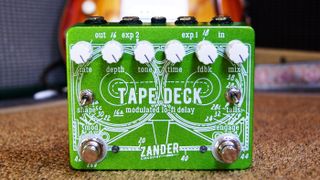
The Zander Circuitry founder talks vintage fuzz and the future of MIDI as his Essex firm prepares for a new chapter in DSP effects...
1. What was the first pedal you built and how did the design come about?
“The first design I sold was a strange feedback loop pedal. I built about a dozen and sold them on Facebook. Word got out and I moved on to making fuzzes. Once I was selling quite a few, my fiancée suggested I put a name to it. ‘Zander’ comes from the second half of my first name [Alexander] and the first pedal I sold under the Zander brand was the SiClone. It was inspired by the Fuzz Face, but it has extra knobs that effectively ‘break’ the circuit to create cool oscillations and sub-octaves.”
2. What do you think makes Zander Circuitry unique?
Although some of our pedals are based on classic fuzz and distortion circuits, our thing is all about making those circuits as tweakable as possible
“Although some of our pedals are based on classic fuzz and distortion circuits, our thing is all about making those circuits as tweakable as possible by adding extra controls, such as different clipping options and expanded EQ so that you can get them to sound good in more or less any rig.”
3. What’s your best-selling pedal and why do you think that is?
“It’s between the Exosphere [Atmospheric Reverberator] and the Tape Deck [Modulated Lo-Fi Delay]. We try to keep prices as affordable as we can. They’re £140 at the moment, but there may come a point when they need to go up slightly.”
Get the MusicRadar Newsletter
Want all the hottest music and gear news, reviews, deals, features and more, direct to your inbox? Sign up here.
4. Is there anything new on the horizon with Zander?
“We’re currently working on three new effects: the Siva, an op-amp version of our American Geek transistor Big Muff-inspired circuit; the Terra Firma, a glitchy stoner rock-inspired power amp distortion; and the Junipero. The Junipero is a multi-modulation pedal featuring eight stereo effects – detune, vibrato, chorus, tremolo, harmonic tremolo, flanger, phaser and through-zero flanger – tap tempo, onboard presets, MIDI and expression control. DSP is where we’re going in future and we’re hoping to bring out more complex reverbs and delays.”
5. Tell us a secret about effects that you’ve discovered...
“Clipping options can drastically affect how drive pedals interact with your amp, so many of ours have a six-way rotary switch to select Germanium, Silicon, Red LEDs, MOSFET, Transistor and None/ no diode. I guess it makes them six times more versatile!”

6. What’s your best tone tip?
“A lot of people find themselves stuck in a rut playing a certain way with certain gear, so my advice is to try out gear that’s maybe a little bit out of your comfort zone. Often that will unlock some really interesting creative choices.”
7. What new pedal triggers your GAS most now?
“The first thing that comes to mind is the Atmosphere from Dr Scientist. It’s a reverb pedal with a Game Boy-style LCD. They make amazing pedals and have been pushing the envelope for the last few years. Also, I love the Hexe [Guitar Electronics] Melusine III. It turns your guitar into a lo-fi warped vinyl kind of sound.”
8. What’s your favourite vintage pedal and why?
The old five-pin DIN MIDI jack is completely unnecessary, so we’re going to be using a regular quarter-inch jack
“The fOXX Tone Machine. That octave fuzz sound is in a lot of music that I really like. We put our own spin on it with the Foxxton Woods. There’s an old 70s fuzz called the Graphic Fuzz made by a company called Earth Sound Research that, as far as I know, hasn’t been put into regular production as a reissue yet – it’s kind of been overlooked and lost in the ether. It’s an amazing-sounding two-knob [filter and boost] pedal, but unlike most fuzzes, it’s op-amp based rather than transistor. It has a really nasty, gritty sound and, at certain settings, you can get all sorts of interesting squeals and oscillations.”
9. What would be on your ultimate three-pedal ’board and why?
“We’re working on a collaboration with Raygun FX called the Avalanche Soda, which is the Raygun Soda Drive and one of the circuits from the Zander Avalanche – that would be my drive sorted! I’d also have the Cooper FX Generation Loss for modulation and the Dr Scientist Atmosphere for reverb.”
10. What problems have effects designers yet to crack?
“Coming up with a consistent implementation for MIDI. We found that to be an issue when developing the Junipero. The old five-pin DIN MIDI jack is completely unnecessary, so we’re going to be using a regular quarter-inch jack. Chase Bliss [Audio] and Empress [Effects] are moving away from the five-pin DIN connection by using quarter-inch jacks, but we just need to standardise the tip/ ring/sleeve [format]. We all followed Boss with a standard power connection, so why can’t we do the same with MIDI?”
Guitarist is the longest established UK guitar magazine, offering gear reviews, artist interviews, techniques lessons and loads more, in print, on tablet and on smartphones Digital: http://bit.ly/GuitaristiOS If you love guitars, you'll love Guitarist. Find us in print, on Newsstand for iPad, iPhone and other digital readers

“This golden gain machine covers the entire spectrum from gritty boost through to full-on fuzz”: Great Eastern FX’s Focus Fuzz Deluxe has got boost, drive, octave, fuzz... everything going on

“This is the only tremolo pedal in the world that lets you plot your own waveform shapes using controls you first got to grips with as a child”: SoundLad Sketchy review











